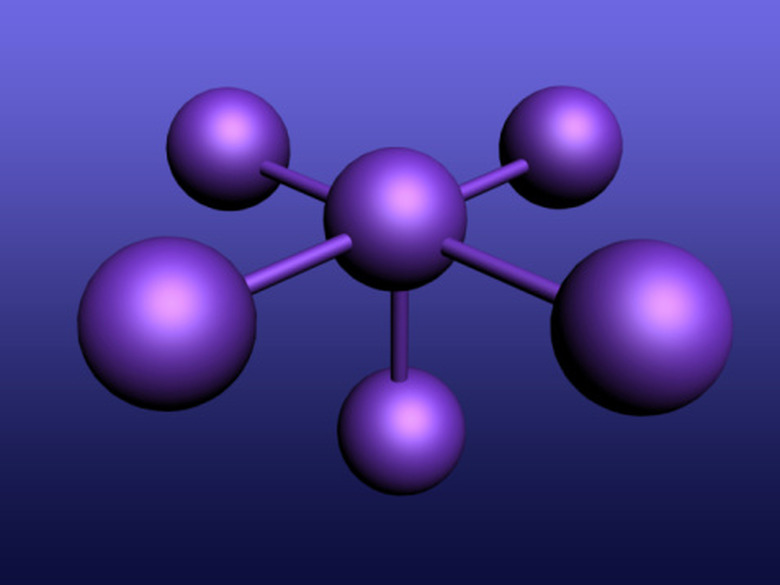How To Make Neon Atoms With Styrofoam Balls
Atomic models made out of styrofoam balls are a classic science project in schools. Neon is a rare gas that is present in minute quantities in our atmosphere. With an atomic number of 10, it has 10 protons and 10 neutrons in its nucleus, which is circled by 10 electrons. In the neon atom model, styrofoam balls in different colors represent these atomic particles, and wire loops show the paths of the electrons.
Step 1
Paint 10 of the 1-inch styrofoam balls with the red paint, using a foam brush. Wash the foam brush and paint the remaining 1-inch balls with the yellow paint. Wash the foam brush again, and paint the 10 small styrofoam balls with the blue paint. Leave the balls to dry.
Step 2
Use the black marker to write a plus sign on the red balls and a minus sign in the blue balls. This represents the positive charge on the protons and the negative charge on the electrons.
Step 3
Place one end of a toothpick in a red ball and the other end in a yellow ball. Push the balls along the toothpick until they're almost touching. Place a dab of glue on one ball where the other will touch it, then push the balls fully together. Hold them in place until the glue is set.
Step 4
Place the end of another toothpick in one of these balls and attach another ball in the same way. Do this until all the balls connect in a spherical shape, mixing the red and yellow balls randomly. This is the nucleus of the atom, consisting of protons and neutrons.
Step 5
Push one end of the 23-inch piece of wire through the center of two blue balls. Measure 3 inches from one end of the wire and bend the short piece at right angles to the rest of the wire. Loop the longer piece of wire into a circle and check that it fits over the atom nucleus. Adjust the loop if it is too small. Close the wire circle by twisting the free end around the end of the circle several times. You will have a loop of wire holding two blue balls with a short piece of wire pointing towards the center of the circle.
Step 6
Place the loop over the nucleus and push the short end piece into the nucleus. Move the two balls so that they are directly across the loop from each other. The two blue balls, electrons, should appear in orbit around the nucleus at a distance of about 2 inches.
Step 7
Push one end of the 30-inch piece of wire through the center of the remaining eight blue balls. Measure 6 inches from the end of the wire and bend the short piece at right angles to the rest of the wire. Loop the longer piece into a circle and check that it fits over both the nucleus and the first wire loop. Adjust the wire circle to fit. Close the loop by twisting the end of the wire around the end of the circle.
Step 8
Place the loop over the nucleus and the first loop so that it is at an angle to the first loop. Push the free end of the wire into the nucleus. Move the eight blue balls so that they are evenly spaced around the loop.
Things Needed
- 20, 1-inch styrofoam balls
- 10, 1/2-inch styrofoam balls
- Red acrylic paint
- Yellow acrylic paint
- Blue acylic paint
- Black marker
- Foam brush
- Toothpicks
- White (school) glue
- 23-inch piece of wire
- 30-inch piece of wire
TL;DR (Too Long; Didn't Read)
Use colored pompoms in place of the styrofoam balls if they are unavailable.
The styrofoam balls can be of any colors as long as you use different ones for the protons, neutrons and electrons.
You can adapt these instructions to make any atom, as long as you know the number of protons, neutrons and electrons it contains.
Cite This Article
MLA
Ash, Christina. "How To Make Neon Atoms With Styrofoam Balls" sciencing.com, https://www.sciencing.com/make-neon-atoms-styrofoam-balls-7734256/. 24 April 2017.
APA
Ash, Christina. (2017, April 24). How To Make Neon Atoms With Styrofoam Balls. sciencing.com. Retrieved from https://www.sciencing.com/make-neon-atoms-styrofoam-balls-7734256/
Chicago
Ash, Christina. How To Make Neon Atoms With Styrofoam Balls last modified August 30, 2022. https://www.sciencing.com/make-neon-atoms-styrofoam-balls-7734256/
